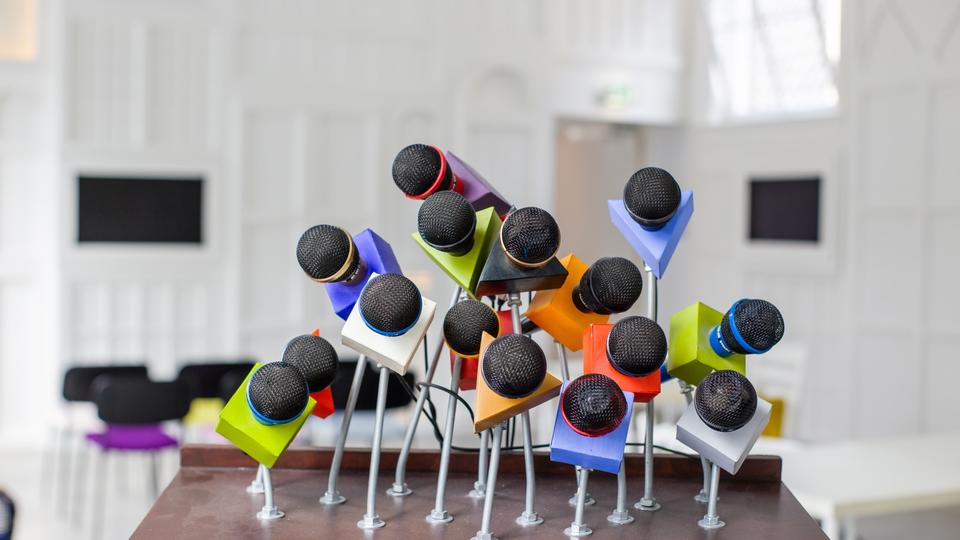
Say It Loud
Have To Make A Presentation? Make It Communicate By Knowing Your Objectives And Weaving A Story
Based on research by Arnaud Chevallier
Have To Make A Presentation? Make It Communicate By Knowing Your Objectives And Weaving A Story
- Have to make a presentation? Make it communicate by knowing your objectives and weaving a story.
- Design powerful slides by knowing the purpose of each and backing that up with great visuals.
- Tailor your presentation for its listeners.
Hatching an audiovisual presentation is tedious work. Sitting through someone else’s bad presentation is even worse.
Like them or hate them, though, presentations are crucial to doing business, according to Arnaud Chevallier, former Rice University professor. Strong presentations are especially key when dealing with work teams – all the more so if you're suggesting major changes in their workplace.
In his recent book Strategic Thinking in Complex Problem Solving, Chevallier looks at a range of communication strategies with special attention to the business bête noire of AV presentations. One of the most common traps, he says, is believing your AV show is merely informational. If transmitting data were all that was needed, after all, it would be more sensible to email a list of bullet points and send everyone back to their desks.
Instead, most presentations aim at getting viewers to act. To do so, the presenter needs to ask herself: What does this presentation need to convey to convince viewers to do what I want?
Our rational selves will have a quick answer: supply evidence. But this only goes so far in changing people’s minds. Aristotle was right -- persuasion relies not on logic alone, but appealing to logic (logos), character/reputation/credibility (ethos) and emotion (pathos).
Persuaders from African griots to Walt Disney animators know how to do this. Tell a story. Not only are we conditioned from childhood to learn from stories, we like them.
In the workplace, however, it's also crucial to shore up ideas with evidence. To do this effectively in an AV presentation, Chevallier suggests, use taglines rather than slide titles. Taglines, declarative sentences that contain both a subject and a verb, summarize a slide’s main idea while the image backs the idea up visually. The goal is a presentation that makes sense to someone outside the room who’s scrolling through the slides on her own.
Great storytelling that grips an audience and teaches at the same time isn’t easy. But it is a teachable skill, based on rhetorical tools. This is one reason why reading to children at an early age is powerful. If they soak in enough examples of excellent narrative, the elements of presenting a good case or story can sink into their brains as well.
Within and outside of business, Chevallier says, a well-told story appeals to listeners' emotions and rationality both. Workplace storytellers can do this by customizing not only their content but also their delivery style, including tone of voice, which can affect listeners as much or more than what’s actually said.
The first step in the process, Chevallier says, needs to be a grand entrance. Make your introduction, the element that journalists call a lede, smashing. If an audience isn't convinced in the five minutes that they want what’s on offer, attention will wander. Chevallier's own book demonstrates the point neatly: Its first paragraph describes Chevallier’s true-life hunt for his beloved lost beagle.
Next, a presentation needs to glide through information as surely and swiftly as a kayak through water. Meander or plod and readers jump ship.
Finally, even in corporate settings, we remain visual animals. Whether it's used as a record or to make a point, a slide needs to arrest the eye. Overall, Chevallier notes, people learn best from words and pictures presented together. Attention to details also pays off: a consistent template, proper font size and style, and a color that contrasts with the font, all make a difference. Avoid fussy graphics or crowding a slide with visual noise.
And make sure to mingle the spoken word with complementary information. A good AV slide gives a plain message, not much text and visuals that enhance the concept conveyed by the slide. Allotting one slide per idea, and using punchy declarative sentences, helps viewers focus the visuals while digesting what they've just heard.
Finally, presenters should see their last slide as top real estate. That’s the one that will loom above during Q&As following the presentation. So don't waste it thanking the audience or listing credits. Instead, use that all-important last word to summarize the biggest idea with intriguing language, eye-pleasing graphics and a swift, certain message. Focus, detail, story, simplicity. That’s all it takes.
And it’s always easier said than done.
Arnaud Chevallier is a former associate vice provost and professor at Rice University.
To learn more, please see: Chevallier, A., (2016). Strategic Thinking in Complex Problem Solving, Oxford University Press.


